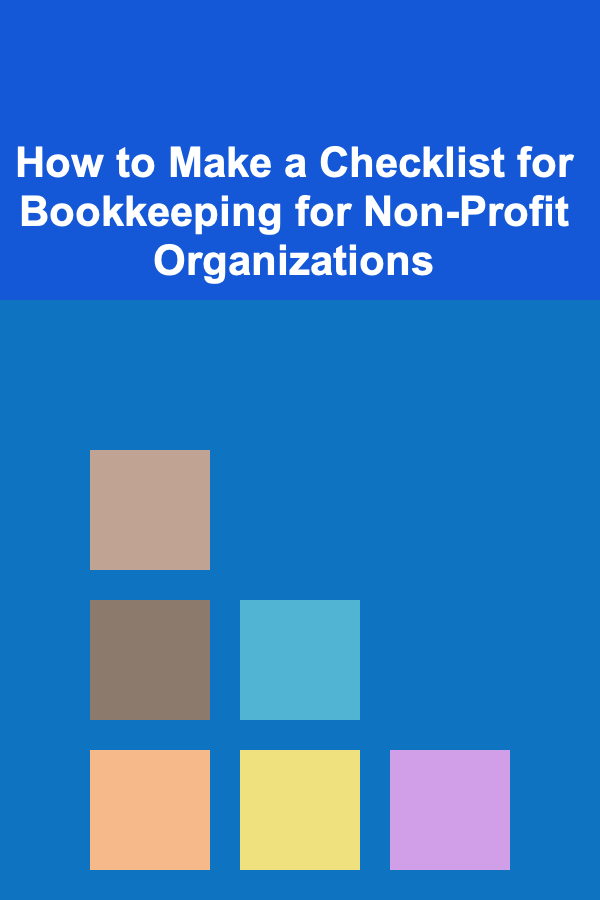
How to Make a Checklist for Bookkeeping for Non-Profit Organizations
ebook include PDF & Audio bundle (Micro Guide)
$12.99$8.99
Limited Time Offer! Order within the next:

Bookkeeping is a critical component of managing a non-profit organization (NPO). It ensures financial transparency, accountability, and compliance with regulatory requirements. For non-profits, keeping an organized and accurate financial record can be challenging, but it is essential to maintain the trust of donors, funders, and regulatory bodies.
Creating a checklist for bookkeeping will help NPOs manage their finances more efficiently. This actionable guide will walk you through the steps of creating an effective bookkeeping checklist, tailored for the unique needs of non-profit organizations. By the end, you'll have a comprehensive understanding of how to maintain accurate financial records and ensure compliance.
Understand the Non-Profit Financial Landscape
Before diving into the bookkeeping process, it's important to recognize the specific financial needs of a non-profit organization. Unlike for-profit businesses, NPOs are driven by mission-focused goals, and their finances are usually supported by donations, grants, and fundraising efforts. Key differences to consider include:
- Revenue Streams: Donations, grants, fundraising events, and membership dues.
- Restricted vs. Unrestricted Funds: Some funds come with conditions on how they can be used (restricted), while others can be used at the organization's discretion (unrestricted).
- Tax-Exempt Status: Non-profits are often tax-exempt, but they must adhere to specific guidelines to maintain this status.
These unique characteristics will influence your bookkeeping practices, requiring you to track specific categories, including revenue sources, expenses, and fund restrictions.
Set Up a Chart of Accounts
The first step in effective bookkeeping is to establish a Chart of Accounts (COA). A COA is a detailed listing of all financial accounts used by the organization, categorized by type. For non-profits, the chart should be divided into categories that reflect the organization's income, expenses, assets, liabilities, and equity.
Here's a basic structure for a non-profit COA:
- Assets
- Current Assets (cash, accounts receivable)
- Fixed Assets (property, equipment)
- Liabilities
- Current Liabilities (accounts payable, payroll liabilities)
- Long-term Liabilities (loans, mortgage)
- Equity
- Unrestricted Net Assets
- Temporarily Restricted Net Assets
- Permanently Restricted Net Assets
- Revenue
- Donations (general, restricted)
- Grants (program, operational)
- Fundraising Revenue
- Program Service Revenue
- Expenses
- Program Expenses (direct costs related to mission)
- Administrative Expenses
- Fundraising Expenses
By setting up a COA, you create a standardized structure that will make it easier to categorize transactions and maintain consistency in your bookkeeping.
Create a Regular Bookkeeping Schedule
Timely and regular bookkeeping is essential for maintaining accurate records. To prevent financial confusion and ensure compliance, establish a consistent schedule for entering and reviewing transactions.
A regular bookkeeping schedule might look something like this:
- Daily: Record any income (donations, grants) and expenses (operational costs, vendor payments). This can be automated using accounting software like QuickBooks or Xero to ensure you don't miss anything.
- Weekly: Review cash flow, check for discrepancies, and reconcile accounts (such as bank and credit card statements). This will help you identify any issues early.
- Monthly: Produce financial reports such as the balance sheet and income statement. This gives you a snapshot of the organization's financial health and ensures that you're adhering to budgetary constraints.
- Quarterly: Review the organization's financial position with the board of directors, ensuring that funds are being used as intended and in accordance with restrictions.
- Annually: Complete year-end financial reports and prepare for the external audit. Non-profits often undergo audits to ensure transparency and compliance.
By keeping up with this schedule, you prevent a backlog of work, which can lead to errors and missed opportunities for improvement.
Track and Record Income Sources
Non-profit organizations usually have diverse sources of income. These may include donations from individuals, government grants, corporate sponsorships, fundraising events, and membership dues. It's crucial to track each income source separately to ensure that funds are properly categorized and restrictions are followed.
For example:
- Donations: Record individual and corporate donations separately. For restricted donations, ensure that they are tracked separately in the COA to prevent misuse.
- Grants: Record grant income according to the specific funders' requirements. Ensure that you maintain a separate record for each grant, including any restrictions on how the funds can be used.
- Fundraising Events: Track the income from each fundraising event, including ticket sales, silent auctions, or raffles. Categorize these funds correctly to determine how much of the revenue is profit.
To ensure accuracy, assign each income source to the appropriate account in the COA and maintain a detailed record of each transaction, including the donor or funder's information and the purpose of the donation.
Track and Record Expenses
Recording expenses is just as important as tracking income. You need to ensure that every dollar spent by the organization is categorized and allocated appropriately.
Common non-profit expenses include:
- Program Expenses: These are the costs associated with the core mission of the organization, such as direct costs for running programs or services.
- Administrative Expenses: These include overhead costs such as salaries for management staff, office supplies, and utilities.
- Fundraising Expenses: These are costs associated with raising money for the organization, including event costs, marketing materials, and fundraising staff salaries.
Make sure to record each expense accurately, and separate them by category. This allows for better reporting and budgeting, ensuring that the organization stays on track with its mission and avoids misusing funds.
Reconcile Accounts Regularly
Reconciliation is an essential task to ensure that the organization's financial records are accurate. Reconcile bank statements, credit card statements, and other financial accounts regularly to ensure that the books align with the actual balances in your accounts.
Reconciliation involves comparing the organization's internal financial records to external financial statements, ensuring that every transaction is accounted for, and identifying any discrepancies. This process helps prevent errors, identify potential fraud, and maintain accurate financial records.
Maintain Separate Records for Restricted Funds
Non-profits often receive donations with restrictions on how they can be used, such as for a specific program or project. To ensure compliance, it's crucial to maintain separate records for restricted funds.
Each restricted fund should be tracked separately, and the expenditures related to these funds must be carefully recorded. This ensures that restricted funds are used appropriately and in line with the donor's wishes. A good practice is to create a separate fund in your chart of accounts for each restricted donation or grant, making it easier to track and report on their usage.
Prepare Financial Statements
At regular intervals, your non-profit should prepare key financial statements to provide an overview of the organization's financial health and performance. These statements include:
- Income Statement: Shows the organization's revenue and expenses over a given period, allowing you to track profitability (if applicable) and financial sustainability.
- Balance Sheet: Provides a snapshot of the organization's assets, liabilities, and net assets, helping you understand the financial position of the organization.
- Cash Flow Statement: Details the flow of cash in and out of the organization, helping to ensure that the organization has enough liquidity to meet its obligations.
These statements should be reviewed by management and the board to ensure the organization is adhering to its financial goals and compliance requirements.
Prepare for Audits and Compliance
Non-profits are often required to undergo audits to maintain their tax-exempt status and ensure transparency to donors and funders. As part of the bookkeeping checklist, ensure that you are prepared for audits by:
- Organizing Records: Keep all financial records, receipts, and supporting documentation organized and easily accessible.
- Compliance with Reporting Requirements: Ensure that all financial reports are accurate and submitted on time to government agencies (such as the IRS in the U.S.) and other regulators.
- Reviewing Policies: Review internal controls and financial policies to ensure that they meet audit standards and protect against fraud or misuse of funds.
An annual audit ensures that the organization is compliant with laws and regulations, maintains transparency with donors, and can continue to operate effectively.
Conclusion
Creating a checklist for bookkeeping in a non-profit organization is an essential step toward maintaining financial transparency, accountability, and compliance. By setting up a proper chart of accounts, following a regular bookkeeping schedule, tracking income and expenses, and preparing for audits, you'll ensure that your organization stays on top of its financial responsibilities.
Effective bookkeeping helps build trust with donors and funders, ensures that your mission remains funded, and allows the organization to allocate resources efficiently. By keeping organized and following the steps outlined in this guide, your non-profit can achieve financial health, accountability, and long-term success.
Other Products

How to Create a Minimalist Workspace for Creative Flow
Read More
How to Create a System for Managing Camp Registration
Read More
How to Create a Winter Wonderland with Holiday Decorations
Read More
How to Maintain Your Organized Living Room Long-Term
Read More
How to Make a Family Memory Book for Special Occasions
Read More